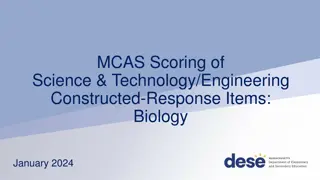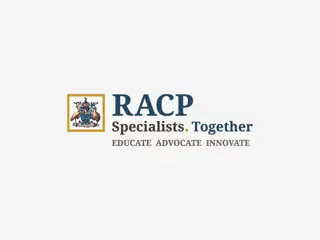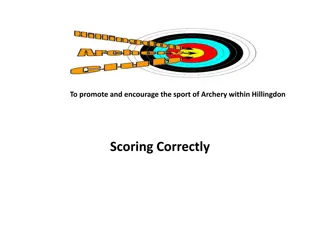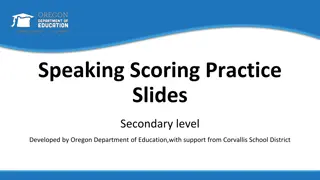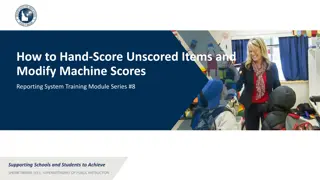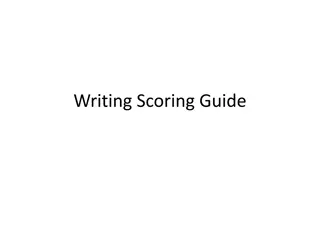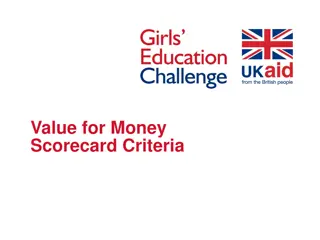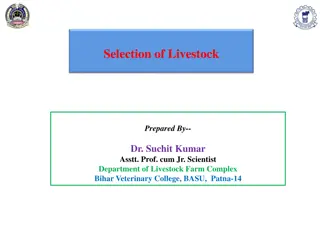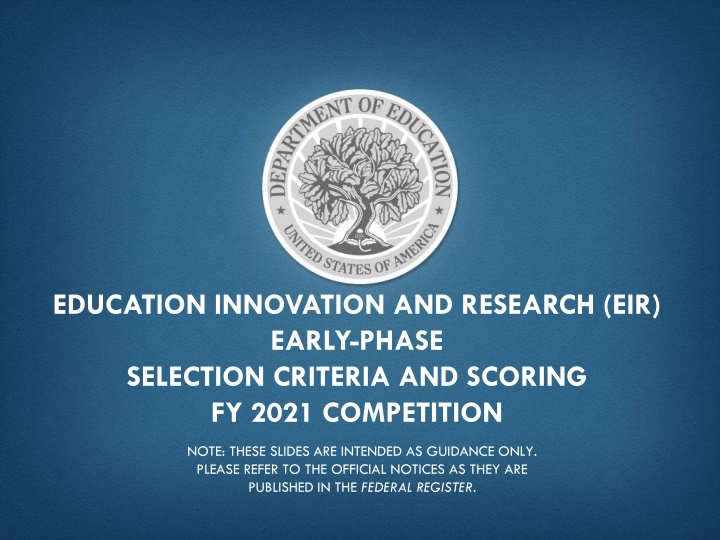
EIR Early-Phase Selection Criteria and Competitive Priorities
Explore the EIR early-phase selection criteria and competitive priorities for the FY 2021 competition. Learn about the significance, project design quality, resources, and management plan adequacy, along with competitive preference priorities. Gain insights into the evaluation process and scoring criteria for educational innovation and research projects.
Download Presentation

Please find below an Image/Link to download the presentation.
The content on the website is provided AS IS for your information and personal use only. It may not be sold, licensed, or shared on other websites without obtaining consent from the author. If you encounter any issues during the download, it is possible that the publisher has removed the file from their server.
You are allowed to download the files provided on this website for personal or commercial use, subject to the condition that they are used lawfully. All files are the property of their respective owners.
The content on the website is provided AS IS for your information and personal use only. It may not be sold, licensed, or shared on other websites without obtaining consent from the author.
E N D
Presentation Transcript
EDUCATION INNOVATION AND RESEARCH (EIR) EARLY-PHASE SELECTION CRITERIA AND SCORING FY 2021 COMPETITION NOTE: THESE SLIDES ARE INTENDED AS GUIDANCE ONLY. PLEASE REFER TO THE OFFICIAL NOTICES AS THEY ARE PUBLISHED IN THE FEDERAL REGISTER.
Selection Criteria and Competitive Preference Priorities Criterion Points A. Significance 20 B. Quality of Project Design 30 C. Adequacy of Resources/Quality of the Management Plan 25 D. Quality of the Project Evaluation 25 Competitive Preference Priority 1: Computer Science (AP3 only) Competitive Preference Priority 2: COVID 5 5 Competitive Preference Priority 3: Equity 5 2
A. SIGNIFICANCE (20 POINTS) 1.The extent to which the proposed project involves the development or demonstration of promising new strategies that build on, or are alternatives to, existing strategies. (15 points) 2.The extent to which the results of the proposed project are to be disseminated in ways that will enable others to use the information or strategies. (5 points) 3
B. QUALITY OF THE PROJECT DESIGN (30 POINTS) 1. The extent to which there is a conceptual framework underlying the proposed research or demonstration activities and the quality of that framework. (15 points) 2. The extent to which the goals, objectives, and outcomes to be achieved by the proposed project are clearly specified and measurable. (5 points) 3. The extent to which the design of the proposed project is appropriate to, and will successfully address, the needs of the target population or other identified needs. (10 points) 4
C. ADEQUACY OF RESOURCES AND QUALITY OF THE MANAGEMENT PLAN (25 POINTS) SLIDE 1 OF 2 1. The adequacy of the management plan to achieve the objectives of the proposed project on time and within budget, including clearly defined responsibilities, timelines, and milestones for accomplishing project tasks. (10 points) 2. The qualifications, including relevant training and experience, of key project personnel. (5 points) 5
C. ADEQUACY OF RESOURCES AND QUALITY OF THE MANAGEMENT PLAN (25 POINTS) SLIDE 2 OF 2 3. The extent to which the costs are reasonable in relation to the objectives, design, and potential significance of the proposed project. (5 points) 4. The adequacy of procedures for ensuring feedback and continuous improvement in the operation of the proposed project. (5 points) 6
MANAGEMENT PLAN ELEMENTS TO CONSIDER 1. Goal(s): A broad statement(s) of what the project intends to accomplish. What do you hope to accomplish by implementing your project? 2. Objective(s): A concrete attainment that can be achieved by following a number of steps. What is your project doing to support the overall program goal(s)? Are your objectives SMART (Specific, Measurable, Achievable, Relevant, and Time-bound)? 3. Performance Measures: A measurable or observable indicator to assess how well objectives are being met. How will you measure the success of your project? 4. Activities: Day to day pieces that must be completed to signal that the grant is on track. 5. Timeline (Start/End Dates): Provide some timeline that will allow task monitoring. 6. Responsible Personnel: Who will be carrying out those activities? 7
MANAGEMENT PLAN EXAMPLE Goals Objectives Measures Activities Start Date End Date Responsible Status Notes Personnel Goal 1: Increase involvement of Smith Elementary School families in their students education. Objective 1.1: Logins on the Smith Elementary School Online Parent Training System will increase 25% from baseline to the end of the grant. Performance Measure 1.1a: Parents reporting in an annual survey knowing about the Online Parent Training System. Activity 1.1.1: Administer parent survey to get baseline data. Activity 1.1.2: Create a pamphlet for parents that describes how to access and use the Parent Portal. Activity 1.1.3: Distribute pamphlet during school-wide events and parent-teacher conferences. Activity 1.1.4: Design a training for parents on using the Parent Portal Activity 1.1.5: Organize a focus group on the Parent Portal to gather parent feedback. 9/1/2016 9/15/2016 Evaluation Team Not Begun 3/1/2016 3/15/2016 Project Director Completed Performance Measure 1.1b: Number of logins per year. 9/15/2016 12/1/2016 Project Coordinator Not Begun 2/1/2016 3/1/2016 Project Director Completed 11/15/2016 12/1/2016 Evaluation Team Not Begun Activity 1.1.6: Deliver Parent Portal trainings. 9/15/2016 12/1/2016 Project Director & Project Coordinator In Progress Scheduled for 10/1 and 11/1. Activity 1.1.7: Administer parent survey. 5/1/2017 6/1/2017 Evaluation Team Not Begun Activity 1.1.8: Collect monthly reports on parent logins. 10/1/2016 12/1/2016 Data Director In Progress Objective 1.2: The percentage of students with parents regularly engaging with the school will increase by 5% every school year. Performance Measure 1.2a: Percentage of students that have at least 1 parent/guardian attend 1 parent-teacher conference per school year. Performance Measure 1.2b: Average parent attendance at school-wide events every school year. Activity 1.2.1 Activity 1.2.2 Activity 1.2.3 8
D. QUALITY OF THE PROJECT EVALUATION (25 POINTS) 1. The extent to which the methods of evaluation will, if well implemented, produce evidence about the project's effectiveness that would meet the What Works Clearinghouse standards with or without reservations as described in the What Works Clearinghouse Handbook (as defined in this notice). (15 points) 2. The extent to which the methods of evaluation will provide performance feedback and permit periodic assessment of progress toward achieving intended outcomes. (5 points) 3. The potential contribution of the proposed project to increased knowledge or understanding of educational problems, issues, or effective strategies. (5 points) 9
EVALUATION EXPECTATIONS EARLY-PHASE Must be an independent evaluation. (EIR Program Requirement) Design is encouraged to have the potential to meet moderate evidence (as defined in the notice). First years of grant are encouraged to focus on developing and iterating the practice in a subset of schools. Later years are encouraged to include an efficacy study of the practice with full-scale implementation. 10
TECHNICAL ASSISTANCE RESOURCES ON EVALUATION 1. WWC Procedures and Standards Handbooks 2. Technical Assistance Materials for Conducting Rigorous Impact Evaluations 3. IES/NCEE Technical Methods papers 4. In addition, applicants may view one optional webinar recording that were hosted by the Institute of Education Sciences: a. Strategies for designing and executing experimental studies that meet What Works Clearinghouse evidence standards without reservations: WWC | Designing Strong Studies Webinar Video (ed.gov) 11
SUGGESTIONS FOR SELECTING AN EVALUATOR Is the evaluator closely familiar with What Works Clearinghouse standards? Has the evaluator conducted evaluations using a variety of designs and methodologies? Has the evaluator published? Does the evaluator have a team of qualified individuals? Is the evaluator independent? Does the evaluator have strategies for recruiting control sites and experience working with districts to gain appropriate consents and to share data? Does the evaluator have experience managing data records and protecting student privacy? 12
SUGGESTIONS FOR SELECTING AN EVALUATOR (CONT.) Is your evaluator familiar with the literature in the area in which you re working? Do you see eye to eye on the goals of the evaluation, and would you have a good working relationship? Have you talked about what might happen to the design and/or the budget if things do not go as planned? Problems with recruitment Problems with attrition Delays or changes to the program Are your expected deliverables clearly defined? Have you clearly defined responsibilities of program staff vs. evaluators, or internal vs. independent evaluators? 13
OVERVIEW OF EARLY-PHASE REVIEW PROCESS Applications sorted and placed in panels by Absolute Priority 2 (General), Absolute Priority 3 (STEM), or Absolute Priority 4 (SEL) Using the selection criteria, applications are scored by peer reviewers who: o Are independent, external experts (content and evaluation) o Undergo intensive vetting and rigorous training o Receive ongoing support during the review There will be three separate rankings for each absolute priority based on average peer review score. 14
SCORING THE COMPETITIVE PREFERENCE PRIORITY Peer reviewers will determine how well the applicant addresses each competitive preference priority, as applicable and will use their own judgment to determine how many of the 5 possible competitive preference points, per priority addressed, will be assigned. Peer reviewers will write a justification of their scoring on the technical review form. Applicants should make clear in their application abstract, narrative, and eligibility checklist whether they are addressing a competitive preference priority. Applicants who do not address the competitive preference priority are not eligible to receive any additional points. 15
TIPS FOR ORGANIZING YOUR APPLICATION We recommend that you organize and sequence your application narrative using the selection criteria. Within each criterion, make sure that you include a direct response to each of the factors under that selection. Reviewers will be instructed that they may use material from anywhere in the application, including the appendices, to score and evaluate each criterion, but they will have an easier job if each section of your narrative is clear, well-organized, and complete and doesn t require them to search for information. When appropriate, use language from the selection criteria to help guide reviewers (For example, This project will be nationally significant because or This project represents an exceptional response to the Absolute Priority because ) 16
EDUCATION INNOVATION AND RESEARCH (EIR) EARLY-PHASE SELECTION CRITERIA AND SCORING



